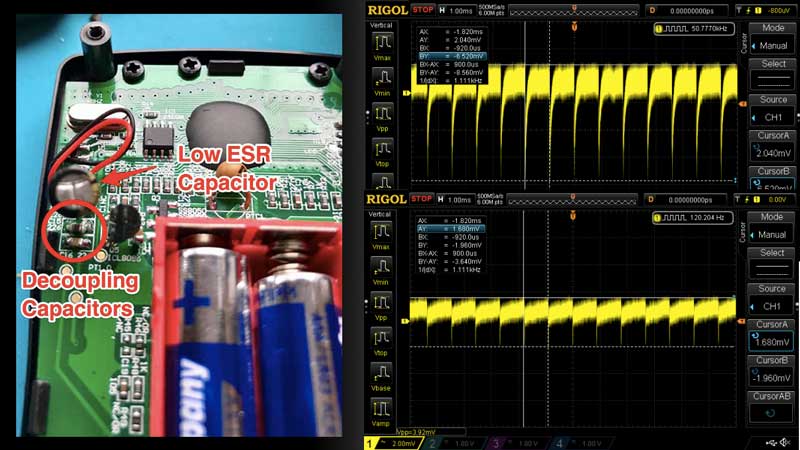We just love it when someone takes apart a bench instrument. There is something about voiding a warranty and then making modifications that hits the spot and in a series of simple modifications, [Jack Zimmermann] dives into the guts if an Aneng AN8008.
The multimeter in question, the AN8008, is a low-cost true-RMS instrument that takes a bit longer to settle on the correct voltage reading than [Jack] would have liked. While poking around, he found that the DC rail inside the meter was host to noise spikes. He theorized that these were being coupled back from an element and proceeded to verify the decoupling arrangement.
The first step was to replace a Rubycon 100 uF capacitor with a Panasonic FM 100 µF which has an ESR of 0.4 Ohms, an improvement on the 1.4 Ohms of stock capacitor. Next came the addition of 0.1 µF, 1 µF and a 10 µF 0805 capacitors and finally a huge 1000 uF 10 V capacity which helped cut down the noise from 30 mV p-p to 3.6 mV p-p. And finally he added decoupling capacitors to the voltage reference chip in accordance with the manufacturer’s datasheet.
These small modifications improved the settling time as well as the stability of the measurements. [Jack] verifies the accuracy against a voltage reference and a bench meter which is good news considering the calibration certificate went out the door anyway.
This is one of the many DMM hacks we have covered in the past such as the Fluke 12E+ hack that enables hidden features though there may be other models out there with possible upgrades.
















ohh, score – have one of them :)
I blame eevBlog
me too :D probably not his intention, but I couldn’t say no to that cute thing :D
Ditto!
I quite wonder why to replace that perfectly good Rubycon cap. This is not a switching power supply where low ESR matters because otherwise the ripple current will slowly cook the caps. In fact, depending on the circuit, the low ESR could be even detrimental to stability, depending on what voltage regulator was used. Randomly adding capacitors without understanding where is that noise coming from (and whether it even matters!) is never a good idea.
Most likely what has cured the problem was the proper decoupling of the reference. I would have probably cut the power trace and inserted a small choke or ferrite bead there too to block the noise coming from the digital part.
If it ain’t broke, fix it till it is!
I should look at the noise under my scope to see hat harmonics occur. However, once turned on, it was evident that the beeper drew enough current with 2xAA NiMH batteries that the backlight dimmed. I have some 2.2 uF, 1206 cape sitting around and populated the same land patterns with 4 of them and dropped in a 220 uF Panasonic electrolytic. Cured the propeller right up.
Well done, more stabilized wrong readings from sh**y multimeter.
Explain.. why sh**y? It’s actually a surprisingly good meter for the money. As was written in the description (see link) of the hack: “It’s also spot on when compared to my HP 34401A 6 ½-digit multimeter.”
I use the HP 34401A (and the Agilent 34401A) a lot at work, these are excellent meters and there’s no question about it that this meter could be used as a standard (in discussions like this).
But having 2 completely different kind of instruments showing the same value, doesn’t automatically mean that the result is correct. But I’m sure we all agree that, when two meters show the same results on various ranges/scales and in various situations it will be very unlikely that both meters are wrong.
the MBC comment “If it ain’t broke, fix it till it is!” made me laugh, brilliant comment.
They are actually extremely accurate, they’ve been tested quite a bit by various YouTubers and the one I have compares favorably to my venerable Fluke bench meter (calibrated not long ago). Where they cut cost is input protection and mechanical durability, but they really are a pretty meter for the price.
Well done, yet another clueless shitpost.
Well done yourself, dipshit.
You have right for your opinion, but mine is that multimeter that needs fixing poorly designed power supply to work correctly is not a good one.
Interesting read. I might need to take another look at some of my gear.
Interesting I have the same meter, though it’s called a Zotek ZT109
Cracked it open, indeed the same layout, just rebadged, but I do not have this settling issue, <2 seconds wile in autorange, that's pretty expected. <1 second while in manual range.
Maybe a lemon? but I would not be surprised if it's a common issue, maybe the capacitors replaced were just especially bad, or a slightly crappier VREF that was oscillating in the conditions.
Click my name if you want an amazon link to the one I found. Makes a good travel meter, shorter leads!
nice article, never thought about doing such a thing because…. perhaps because a multimeter “has always been around” since before I could make such adjustments so I never thought about modding it.
I did this ghettostyle and it still made a big difference… I put a Nichicon 220uF 25V cap in parallel with the stock one, added 0.001uF / 0.1uF / 1uF ceramics underneath the electrolytic and soldered a 1uF on top of the reference capacitor. These were parts sitting around. The meter is easily 4X faster stabilizing now, if not even more. Thanks to guy with original posting.
where did you connect the 1000uf cap?, what brand is it? and is it low esr?